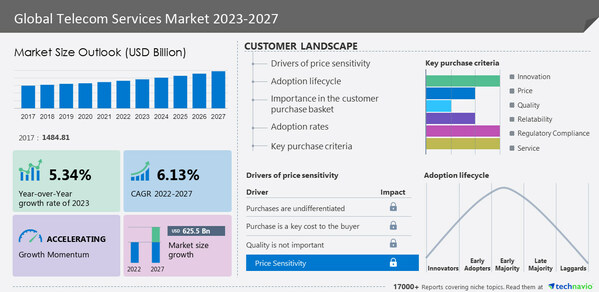Technavio: APAC region leads global telecom services market with 33% growth
According to a new report by Technavio, the telecom services market is forecast to grow by $625.5 billion from 2022 to 2027, progressing at a CAGR of 6.13% during the forecast period. APAC is estimated to contribute 33% market growth (more details below). The report offers an up-to-date analysis regarding the current global market scenario, the latest trends and drivers, and the overall market environment.
Increased demand for broadband is the key factor driving the growth of the global telecom services market. The demand for high-speed broadband connections has increased due to the rise in the number of internet users globally. As a result, the companies are providing faster speeds and higher bandwidths by upgrading their network infrastructure. The world is becoming connected through the internet so the demand for telecom services is growing rapidly. Furthermore, people and businesses require fast and reliable connectivity to access information and services, stay connected with each other, and conduct their daily activities. Hence, these factors will boost the growth of the telecom services market during the forecast period.

Telecom service is provided by a telecommunication provider or a specified set of user-information transfer capabilities provided to a group of users by a telecommunication system. Telecom services include all forms of voice telephony and data transmission as well as leasing of circuit capacity.
Market Drivers:
- Increased demand for broadband
- Mergers and acquisitions
- Increase in global mobile data traffic
- Technological advancements
- Adoption of 5g technology
- High investment by vendors
Challenges:
- Regulatory compliance
- Increasing competition among vendors
- Growing concerns for environment
APAC region leading:
- APAC dominated the global telecom services market with the largest market share in 2022.
- APAC is the world’s most populous continent, and its population is increasing rapidly.
- As the population grows, so does the demand for telecom services, such as mobile phones and Internet access.
- Many APAC countries are experiencing rapid economic development, which is increasing the demand for telecom services.
- As people become more affluent, they are more likely to want access to mobile phones and high-speed Internet. APAC is experiencing a significant shift from rural to urban living.
- As people move to cities, they require more advanced telecom services to stay connected and conduct business.
- The rapid pace of technological change is transforming the way people live, work, and communicate.
- In APAC, there is a strong focus on digital transformation, which is driving the demand for telecom services.
- Thus, due to population growth, economic development, urbanization, and digital transformation, the demand for telecom services is booming in APAC, which may positively impact the growth of the global telecom services market during the forecast period.In 2020, the COVID-19 pandemic increased the demand for telecom services as more people work, learn, and socialize from home.
- As a result, there has been a surge in the demand for high-speed Internet, video conferencing, and online entertainment services.
- The increased demand for telecom services has also led to network congestion in some areas.
- With more people using the Internet simultaneously, network speeds can slow down, making it difficult for people to work and communicate effectively.
- The pandemic has disrupted global supply chains, which has impacted the availability of telecom equipment and devices.
- This has led to delays in the rollout of new infrastructure and has impacted the supply of mobile devices.
- However, in late 2020, the initiation of large-scale vaccination programs led to the lifting of lockdown restrictions and the resumption of industrial operations, which increased the demand for telecom services in commercial end-users as many people started going to offices.
References:
One thought on “Technavio: APAC region leads global telecom services market with 33% growth”
Comments are closed.



MTN Consulting: Network Operator Forecast Through 2027 Mid-Year Update
Telecom is essentially a zero-growth industry. Specific countries and companies do grow from time to time, in part from market share shifts, the different timing of growth cycles, or M&A. But global telco revenues have hovered in a narrow range ($1.7-$1.9 trillion) since 2011, and this will likely remain true through 2027.
In 2022, revenues were $1.78T, and will grow an average annual rate of 1.8% to reach $1.95T by 2027.
Capex continues to vary with technology upgrade cycles (e.g. 5G) and government actions (e.g. newly issued spectrum, or rural fiber subsidies). In 2022, capex totaled $322B, or 18.1% of revenues; that’s an all-time high capital intensity, for coverage timeframe (2011-present). Capex will decline slightly through 2025, though, and then rise modestly again to reach $321B in 2027, which would be a 16.5% capital intensity. US capex surged in 2022, but will drop dramatically in 2023; we already expected this, though, so the current forecast is not significantly different. Software capex is growing more slowly than expected, and now likely to remain under 20% of total capex for the forecast period.
Headcount in telecom is declining faster than expected, and now likely to fall below 4.2 million in 2027, from just under 4.6 million in 2022. Labor costs per head will revert to a growth trajectory in 2023, as telcos develop a more IT/software-centric workforce.
https://www.mtn-c.com/product/network-operator-forecast-through-2027-mid-year-update/